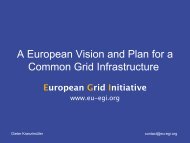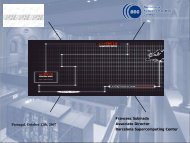e-Infrastructures Roadmap - Internet Society Nederland
e-Infrastructures Roadmap - Internet Society Nederland
e-Infrastructures Roadmap - Internet Society Nederland
- No tags were found...
You also want an ePaper? Increase the reach of your titles
YUMPU automatically turns print PDFs into web optimized ePapers that Google loves.
e-<strong>Infrastructures</strong> <strong>Roadmap</strong>IntroductionIn the 20th century Europeans produced the first computer, 1 invented packet switching 2 (the basisfor the technology operating the internet) and more recently conceived the world wide web. 3However, Europe has fallen behind in reaping the benefits of its own innovative force. Now, withgrid technology as a strong catalyst and with the parallel deployment of a world leading networkinginfrastructure, Europe has a major chance to regain its former leading position. The e-Infrastructureis seen as the spinal cord of the European Research Area delivering advanced facilities driving thetesting and the first deployment of new innovative technologies.The current technological leadership must be capitalized on while there is still very much a greenfieldsituation that allows us to grasp the new research and business opportunities. Europe must accept thechallenge to develop and build the e-Infrastructure required for the information age now– an investmentopportunity not to be missed. With new contenders – like the fast-growing Asian economies –already looming on the horizon, Europe needs to seek the front ranks again if it wishes not to bemarginalized in due course.In the next decades science and research will change fundamen tally in the way they operate, so thescope of thought should surpass the current situation and needs. In order to support Europe widecommuni ties that are able to interact in a global environ ment as equals, it is impor tant to encouragesharing of electronic infrastructure resources as a way to create suitable condi tions for cross-disciplinaryinter action. This will provide fertile ground for innovation and eventual industrial exploitation anduse in education.There is no doubt also that the impact of new infrastructures will be far beyond science, as waswitnessed with both the internet and the World Wide Web. Possible uses of the new infrastructuresoutside of the research and education communities include commercial services, security and disastermanagement, digital libraries, entertainment (digital television, rich media distribu tion, gaming) ande-Learning. Enhanced competitiveness in these areas positively impacts vast parts of the Europeaneconomy and offers tremendous opportunities. Collaboration and information exchange with industry– both as supplier and as a user community – and the rest of the globe is necessarily a part of theentire approach. Of course combining the major efforts from the research area and those from industrywill be of great help to create a mature and sustainable market through orchestration and convergenceof competing and complementary technologies. 4What is an e-Infrastructure?The term e-Infrastructure is used to indicate the integrated ICT-based Research Infrastructure inEurope. Of course such an infrastructure builds on many ICT components that have been around forquite a while, such as networks, supercomputers and storage. There are many interdependencies betweenthese components, so their future should be planned coherently. The e-Infrastructure viewpoint allowsto join and fit all interrelated infrastructures together and start to think of them as a system – and optimisenot for each individual part, but for the whole. The prime goal of the e-Infrastructure may be to supporte-Science, e-Health and e-Culture, but at the same time opportunities are created for many other applicationdomains that contribute to society such as e-Commerce, e-Government, e-Training and e-Education.A competitive e-Infrastructure is indispensable for the numerically oriented branches of the sciences.Well known examples are climate and earth system research, water management, fluid dynamics,biophysics, theoretical chemistry, astrophysics, quantum chromodynamics, nanostructure physics andhigh-energy physics. 5 Both the increasing progress on mathematical models and the complexity ofsimulations cause the demand of these subject areas for computing cycles to be almost without limits.But also from traditionally less computer oriented areas such as the social sciences, the humanities andbiodiversity there is an strong trend towards mass deployment of ICT to manage the large variety ofdecentralised data sources and find novel approaches to traditional problems.4 However, it is not a goal in itself. Industry is made up from a large amount of autonomous actors that cannot possibly allbe involved in the same level with every development, and much happens in parallel only to be decided by the market.1 Konrad Zuse, 1936. See: Rojas Raul (ed):‘Die Rechenmaschinen von Konrad Zuse’, Springer Verlag, 1998.So while a broad coalition of industrial partners can be a decisive help in the successful adoption of certain technologies,2 Donald Watts Davies, 1965. See: D. W. Davies, K. A. Bartlett, R. A. Scantlebury, and P. T. Wilkinson,the future remains as unpredictable as ever. Even if market leading industrial partners are heavily involved throughout‘A digital communications network for computers giving rapid response at remote terminals,’ ACM Symp.the entire process in a fundamental way, other technological solutions from smaller or even unknown competitors might8 Operating Systems Problems, Oct. 1967.well prevail – even if they are technologically inferior and/or incomplete.3 Tim Berners-Lee, 1989. See: http://www.w3.org/People/Berners-Lee.5 For more examples see: ‘Recommendation on the Installation of European Supercomputers’, Wissenschafsrat, november 2004.9







